Dave Unwin’s airtest of the Piper PA-28 Cherokee Archer LX first appeared in the August 2019 edition of Australian Aviation.
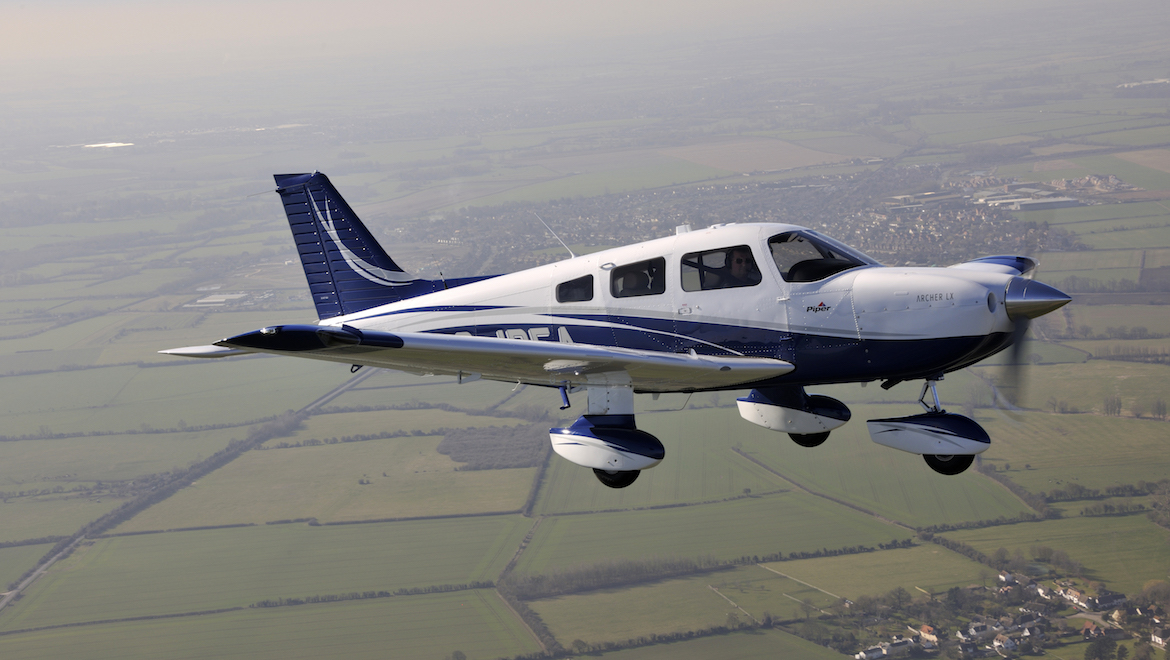
Although every pilot has heard of the PA-28, they may not know the whole story.
For decades, a steady stream of “rag ‘n’ tube” taildraggers had flowed from Piper’s Lock Haven, Pennsylvania plant, and this type of aeroplane was the company’s stock in trade until the introduction of the iconic PA-24. The success of this all-metal aircraft and its tricycle undercarriage confirmed what Piper’s board already knew – their product line needed updating and there was a serious need for a trainer to complement the more advanced Comanche.
Similar in design and construction to the PA-24, the PA-28 was designed in 1960 by John Thorp and Fred Weick and entered production the following year. It met with instant approval from both flight training schools and private owners, and Piper subsequently produced well over 30,000 spread over 40 different variants on the same Type Certificate, ranging from 140hp two-seaters to 235hp four-seaters, with normally-aspirated and turbocharged engines, and both fixed and retractable undercarriages.
The test aircraft, G-IBEA, is a 2018 Archer LX, and I’m introduced to it by Sean Brown, CEO of UK Piper dealer British European Aviation at BEA’s Booker (Wycombe Air Park) base. From a distance it looks essentially like any other Archer, although the myriad roof-mounted ariels – and particularly the double blade-type for the ADS-B – provide a subtle but significant clue that this is not your grandfather’s, or even your father’s, Archer.
The walk-around reveals nothing especially interesting, although I do think that the build quality and overall finish is of a very high standard, and considerably better than earlier models.
Power is provided by a 180hp Lycoming, but it is now a fuel-injected IO-360 that is hidden underneath a composite cowling. It turns a two-blade fixed-pitch metal Sensenich prop and is fed from a pair of tanks located in the leading edge of each wing with a combined capacity of 182 litres.

A small hatch in the top of the cowling provides access to the oil dipstick. The undercarriage features fully-faired telescopic struts and all three wheels are the same size.
The wing consists of a centre-section that carries manually operated flaps and tapered outer panels fitted with simple “flat-plate” ailerons. The flaps have four settings, 0, 10, 25 and 40 degrees.
A sensibly-sized door on the starboard side provides access to the big baggage bay which can carry up to 90kg. An interesting facet of the wide-span narrow-chord stabilator is that the anti-servo/trim tab is almost as large as the stabilator’s trailing edge. All the control surfaces are operated via cables, pulleys and bellcranks and are corrugated for extra stiffness. Unsurprisingly, the landing, taxi lights and position lights are now LEDs.
In common with many other Pipers, access to the cockpit is only possible from the starboard side as there is only one door. However, it opens wide, while the non-slip wingroot walkway is also sensibly sized. Thus far, I hadn’t noticed any particularly noteworthy changes from previous models, although there are in fact several differences between “Echo Alpha” and an LX I tested at Vero Beach seven years ago.
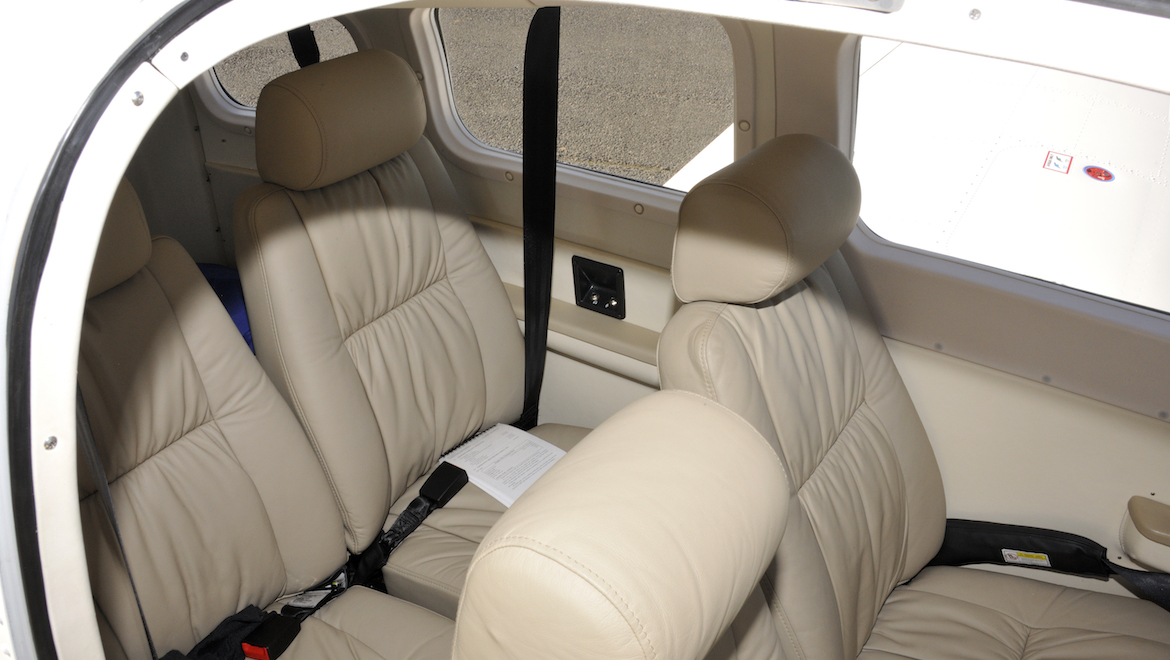
The real transformation has occurred in the cockpit, or more precisely, the panel. It is very different. The previous combined Garmin G500/analogue arrangement has been replaced by a purely digital display, and there are no analogue instruments at all – not even a compass.
At its core is the new G1000NXi, which Garmin has certified for a wide range of aircraft. Indeed, the overall arrangement of both the panel, throttle and control yoke is reminiscent of a Piper M600 that I tested in 2017 – there’s even a takeoff-go around (TOGA) button set into the throttle – and is doubtless now standard fit to all new Pipers. This commonality undoubtedly makes transitioning up to one of the M-class a lot easier.
The instrument panel carries two 12-inch screens, a primary flight display (PFD) and a multi-function display (MFD), with an Aspen Avionics EFD-1000 “Evolution” standby instrument to the left of the pilot’s PFD. The EFD-1000 is undoubtedly a much more useful device than the altimeter, attitude and air speed indicator it replaces, as it also has navigational data.
Turning the master and avionics on (most of the electrical switches are in a neat overhead panel, which makes an already uncluttered instrument panel even clearer) the first things I notice are that it “boots up” much more quickly, as it now uses a dual core processor (earlier G1000’s used a single core). Everything is quicker and the graphics are sharper. The radio appears to turn on instantaneously, allowing us to check the ATIS while the rest of the system initialises.
Although it looks very much like the hugely successful G1000, there are significant enhancements on practically every level. In fact, the G1000NXi makes life easier even before you arrive at the airport as it is possible to plan the entire flight at home on an iPad or similar device and then wirelessly upload all the data (such as waypoints, VRPs, SIDS and STARS) into the aircraft.
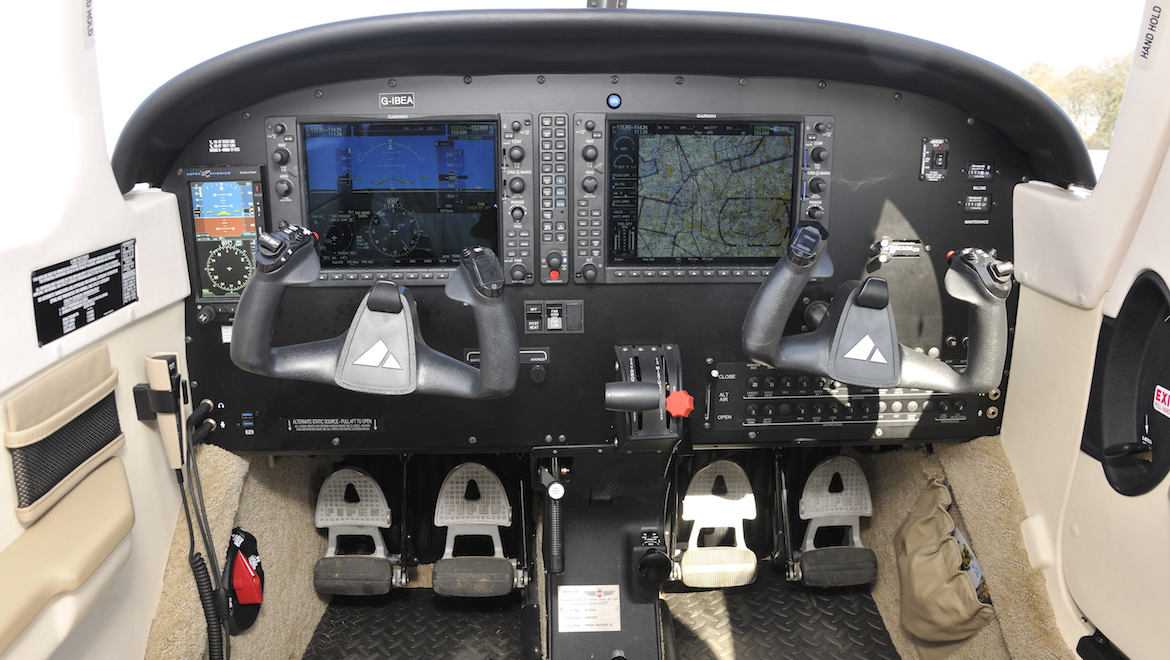
This app-to-avionics interface not only saves time but also reduces the chance of making a mistake as you can plan the flight in comfort. Furthermore, should you need to update any databases this can also be done at home and then uploaded wirelessly.
Taxi and takeoff is typical Archer, although the start-up is slightly different as the engine is now injected. Although the maximum takeoff weight (MAUW) for “Echo Alpha” is some 185kg heavier than the original 1960 PA-28, it does have 30 more horses. Ambient conditions are a freakishly warm (for an English February!) 21°C, with a gentle crosswind from port. The pilot’s operating handbook claims only 490m is needed to clear a 50ft obstacle at MAUW on an ISA day and this seems perfectly plausible.
As we move into formation with the photographer’s R66 helicopter I get the distinct impression that the handling seems crisper than any other Archer I’ve flown. It could be the newness of the airframe (and most of us have flown either a -28 or its Kansas-built contemporary the C172 feeling like the yoke was connected to the ailerons with well-worn bungees) but “Echo Alpha” really does feel quite taut.
The camera shoot doesn’t take long, although the Electronic Stability Protection (ESP) doesn’t like the “breaks”. Basically, when Keith the cameraman calls “3-2-1-break” I like to roll away from the cameraship, with as much bank as I can get, up to and occasionally past 90. However, the ESP system takes a dim view of such behaviour! It uses the same actuators, processors and sensors as the GFC700 autopilot, but functions autonomously.
Essentially, if pre-set parameters in roll, pitch or airspeed are exceeded it introduces a correcting force while still providing the pilot with feel. If you roll past 45∞ of bank there’s a subtle but significant resistance through the yoke, and past 60∞ it becomes a powerful self-righting force. Keith likes a nice crisp break, so I temporarily disable it by pressing the AP disconnect button. With all the photos “in the can” Sean passes me some “foggles” and I get my head down and my eyes on the instruments.
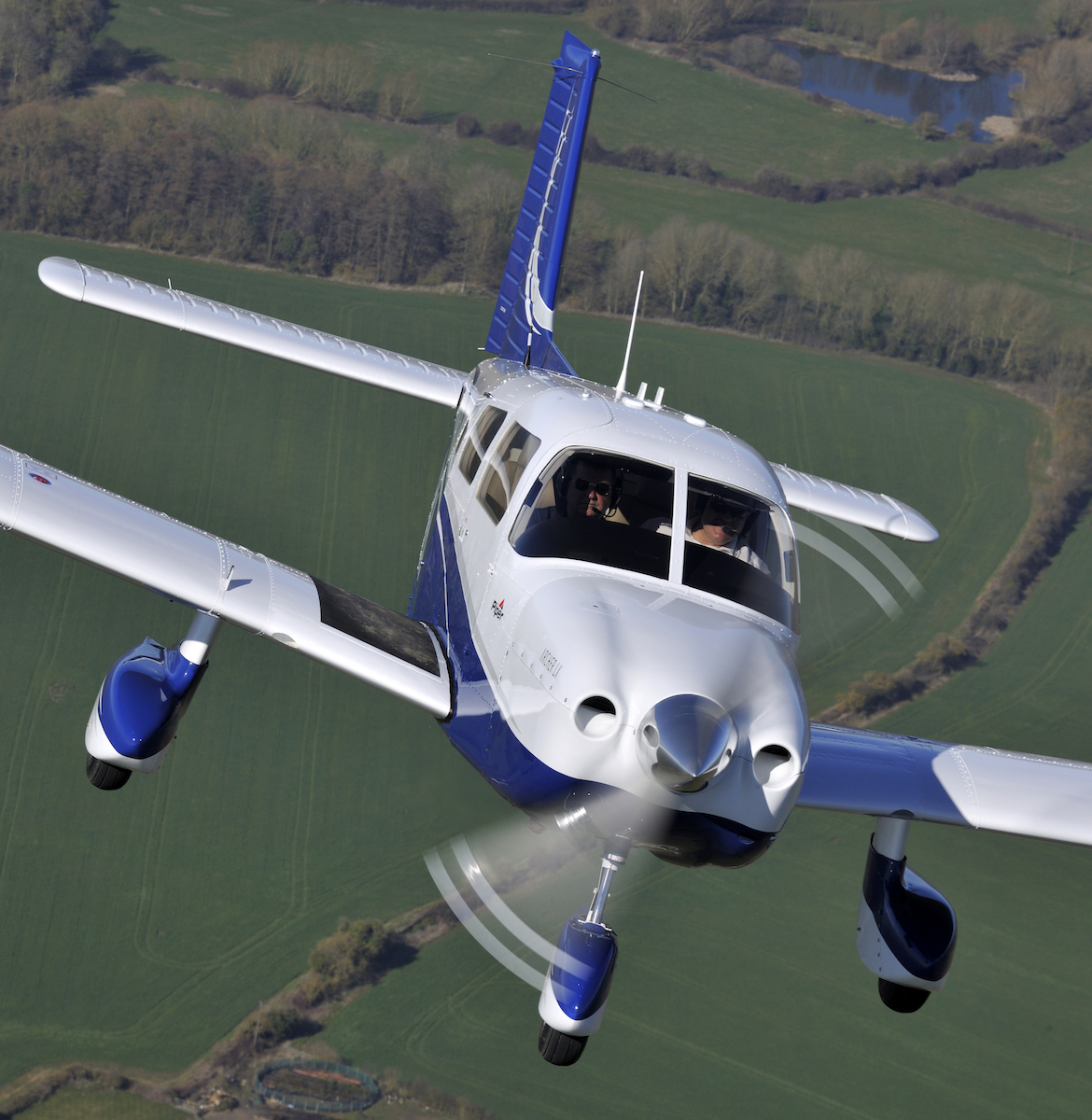
At this juncture I would typically assess the cruise performance, then control and stability, but the formation session with the R66 has told me all I need to know about control, while I suspect the stability is the same as any other Archer. Due to time constraints, I didn’t get a chance to examine the cruise performance at the optimum operating altitude (typically around 8,000ft, although it has a service ceiling of 14,000ft) but 75 per cent power typically gives a true air speed of around 125-130kts while consuming around 38-40 litres of fuel an hour.
Obviously, if you fill the tanks you can’t fill the seats, (but if you do fill the tanks the range is over 520nm, plus 45 minutes IFR reserve). A more representative “mission profile” is that it can easily carry about 300kgs (say three adults, or two adults, two children and some luggage) over 300nm.
Now, although I am instrument rated for SEL, MEL and SES, I am not an “instrument pilot” – and my rating is definitely not current. Nevertheless, (and despite it being a little bumpy) within five minutes I was flying to within +/-50ft, +/-5 degrees and +/-5kts, which would’ve been a “pass” on a check ride.
However – and I can’t emphasise this enough – that says a lot more about the Archer’s capabilities than my own. With a 12-inch PFD there’s a nice, big clearly defined horizon, plus large “command bars” to follow, accurate and well-rendered “synthetic vision” and an easily interpreted “Highway In The Sky” presentation. Finally, if while hand-flying I’d become incapacitated by either illness or vertigo all I’d have to do is punch the blue “LVL” on the panel, and this automatically engages the powerful autopilot and returns the aircraft to straight-and-level flight.
As we head back towards base Sean says he wants me to fly a GPS-only LPV approach into Booker. One of the many extremely useful facets of the G1000NXi is that you can fly such approaches down to ILS-comparable minimums at airfields that are not equipped with ground-based electronic approach aids, such as an ILS or VOR/DME.
However, the circuit is extremely busy, and the controller (who does sound a little stressed) isn’t as enthusiastic as we are about the idea! Instead, I fly the standard overhead join, but keep the foggles on and just follow the command bars which Sean drives through the heading bug. On short final Sean says “OK, look up”, and the runway’s right where it should be, although if the visibility was restricted and I wasn’t quite sure where the runway was I could still continue as the synthetic vision is overlaid on the PFD. Furthermore – and to illustrate just how accurate the system is – the synthetic vision is identical to the view through the windscreen. I’m slightly “hot-n-high” but a bit of a slip gets us back on the ‘slope, and after a bit of a float a smooth touchdown rounds off another fascinating flight.
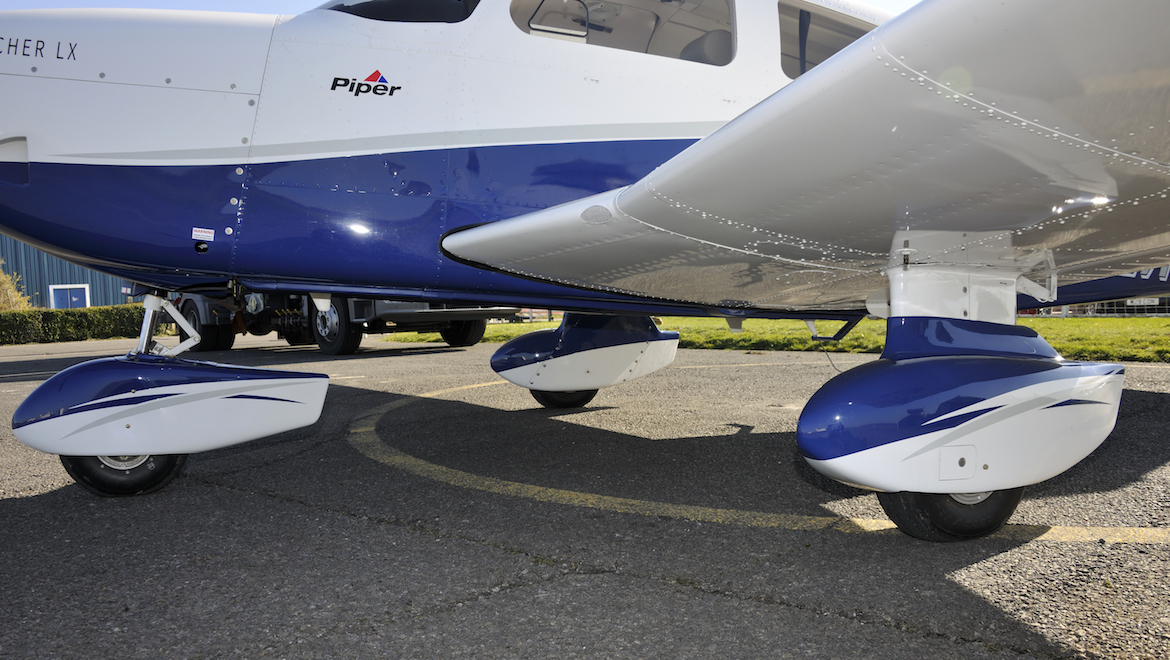
Conclusions? Well when tasked with this test I was initially reluctant. I’d flown an earlier LX in 2012 and the diesel-powered DX in 2015. Was a 2018 LX really going to be that different, or was it simply the aeronautical equivalent of putting a modern satnav and infotainment system in an old Holden panel wagon? No. The engine may be the heart of an aeroplane but the instrumentation and avionics are its “brain”. And installing the NXi has given the Archer a very powerful “intellect”.
Are pilots buying it? Well, Piper has sold 32,000 PA-28s over the last 60 years and sales are if anything as strong as ever, as it delivered around 100 in 2018.
Why? Of course, for the burgeoning airline academy market it makes perfect sense. With its all-digital cockpit, synthetic vision and even a TOGA button it’s the perfect low-cost lead-in to an airliner’s cockpit. However, the type still also appeals to the discerning touring pilot. The performance allows a safe departure from a country airstrip, while the integrated avionics would easily allow an approach and landing into Sydney Airport (if you could get a slot!)
And there’s another important factor that’s well worth bearing in mind when touring in a Piper PA-28. If you should experience any issue with either the airframe or engine in all probability the mechanic will be familiar with both Piper and Lycoming products. But it is the integrated avionics that really separate this Archer from every other one that I’ve flown.
Remember, this aircraft is an SEP. It’s a Piper PA-28 not an MD-82, yet in some respects its better equipped than a jetliner. And I’m not exaggerating. Sean said the same thing, and as he used to fly 747-400s for BA he should know. The -400 doesn’t have synthetic vision for a start! And who ever thought you’d see a TOGA button in a PA-28?
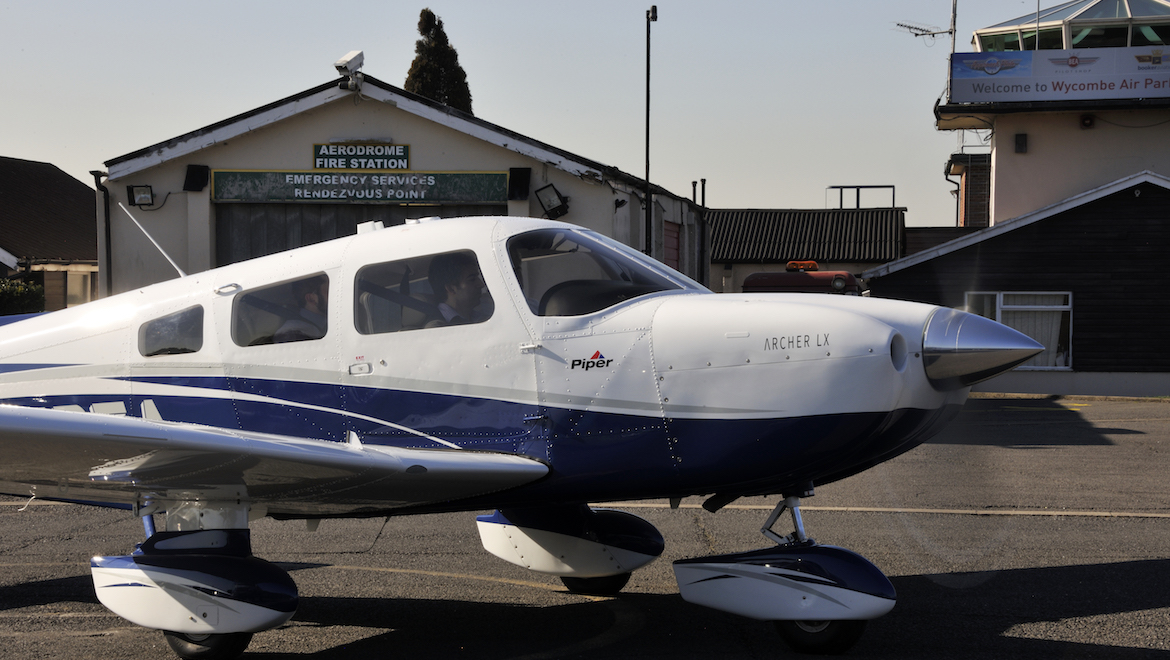
This story first appeared in the August 2019 edition of Australian Aviation. To read more stories like this, subscribe here.













